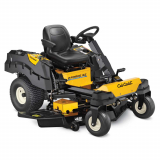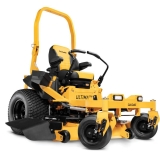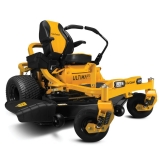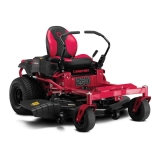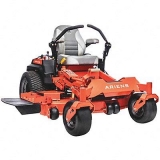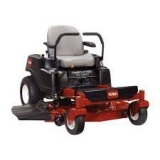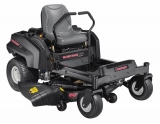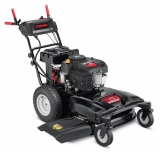Best Zero Turn Lawn Mowers Reviews & Guide
Newest zero turn mower reviews
What Is A Zero Turn Lawn Mower?
Zero-turn lawn mowers take mobility to an unmatched level. Most riding mowers have to settle for being driven or towed in a sweeping arc of some magnitude or another to change directions. Walk-behind mowers typically have to be pivoted on their rear wheels to re-direct their swaths. A Zero-turn lawn mower doesn’t actually so much “turn” at all as rotate in place, often with two rear drive wheels and a pair of swiveling wheels in front rotating independently based on the driver’s input. Rotating both of them in reverse will reverse the mower’s travel direction. It can also pivot from a stationary position around one drive wheel if the other remains stationary, turn in a circle of any radius, or make a classic z-turn around a point midway between the wheels. Most z-turn mowers are based on dual throttles respectively controlling the speed of rotation each drive wheel’s direction instead strictly relying on a single steering wheel. The seated driver ordinarily moves levers mounted from waist to shoulder height to operate them but the engine throttle remains entirely separate. Most are guided by either a steering wheel or joystick.What Are The Different Types Of Zero Turn Lawn Mowers?
Compact Residential
Not every zero-turn mower needs a massive deck. By the standards of their class, a compact residential mower’s deck might “only” come in at 32 to 42 inches, but that’s because they are specifically made for superior performance with a smaller footprint and competitive power at affordable prices comparable to a respectable riding mower.Residential
If you have around one to two acres of fairly level lawn without any slopes, ditches or uneven and craggy terrain to complicate the job, a zero-turn mower will do just about anything a lawn tractor can but with sharper movement and about 30 percent faster cutting at an average 4-5 mph. Decks typically run between 30 and 46 inches but many are only compatible with bagging or light-duty yard card attachments due to their less-hardy transmissions. Expect about 16 to 21 horsepower.Estate Class
When jobs escalate to more hilly estate-sized yards with slopes varying up to around 10 to 15 degrees, a heavier-duty residential zero-turn mower’s decks ranging from 42 to 60 inches in width and 5-8 mph top speeds do the trick from about two to six acres. These bigger mowers can outpace a lawn tractor by around 50 percent with a smooth ride on bigger tires, the added maneuverability and strength of larger, engines delivering usually somewhere between 22 and 27 horsepower, and fabricated decks with extra-sturdy welding.Entry Level Commercial
When just starting out with commercial mowing, many landscapers don’t need anything fancy. A basic stand-on zero-turn mower will often do the trick. These models often don’t accommodate many attachments, but with decks ranging from roughly 42 to 60 inches, around 21 to 35 horsepower, and to speeds between 8-13 mph, they handle steep inclines notably well for their class and maneuver extremely deftly. If you want a zero-turn mower that makes a tremendous dent in your mowing time with few frills, look no further.Commercial
These are the mowers pros look to upgrade to when the size of their jobs escalates. Their speeds easily equally those of a stand-on mower but their massive heavy-duty fabricated decks start at 60 inches and run clear up to topping 100 inches, making them ideally designed for yards larger than six acres. As comfortable as their built-in suspensions are durable, expect 27 to 38 horsepower from their powerful engines and cast-iron hydro transmissions.Gas Powered
These mowers easily provide the greatest pure, consistently dense stream of power to generate reliably smooth cuts from start to finish. They require the most constant maintenance and are easily the noisiest option, but gas-powered mowers also tend to be the most durable machines and the only ones with a power source that stands up to the largest and longest jobs.Electric
These mowers definitely pass performance tests in terms of clean cutting and the ability to stand up to stubborn strains of grass with quiet operation, minimal maintenance, and no pollution. However, they also disqualify themselves from extremely large yards with cripplingly limited battery life and power that still doesn’t quite match up evenly with a gas mower.Front Engine
Positioning the source of your zero-turn mower’s power in front sacrifices power in favor of improved speed, which is certainly an asset for finishing large, flat lawns extraordinarily quickly. You can usually distinguish these mowers by their larger front wheels.Rear Engine
Many zero-turn mowers carry about 75 percent of their weight in back, much of it accounted for by the engine. That may slow a number of mowers down, but in return, this design choice generates substantially more power while making them easier to store and maintain when not in use by taking up less space. Here’s the catch: being that rear-heavy leaves them prone to disastrous rollovers when mowing down or across steeper slopes with an inclination greater than about 13 degrees.Lap Bar/Steering Wheel
The choice between steering with a wheel or lap bars has significant perks on both sides. Lap bars guide the mower by pushing and pulling two levers forward and backwards as needed to change the orientation and acceleration of the front drive wheels, making for an experience much like guiding a shopping cart. While I believe this milks the greatest benefit from a zero-turn mower’s signature fluid motion, many owners prefer a steering wheel for the ability to naturally guide their mowers the same way they would operate an automobile. It’s a case of accepting a bit of a learning curve or settling into instant, intuitive comfort.Who Is A Zero Turn Lawn Mower Ideal For?
Landscapers
Professionals need multitalented mowers up to nearly any task and tricky, tight turns while still keeping their cuts close to edges, smooth, and precise as the day is long.Homeowners With Large Yards
These are big, fast mowers with large decks and plenty of horsepower, more than enough machine to manicure sprawling spreads.Golf Courses
Considering all the obstacles, twists, turns and sheer acreage to cover, there’s nothing better to groom the links in as little time as possible.Property Managers
Time is money and a zero-turn mower is as efficient and versatile as they come. People With Health Conditions — Not only will a zero-turn mower make short work of nearly any yard, they are comfortable and easy for owners with tenuous health to handle.Why Buy A Zero Turn Lawn Mower?
Not every yard calls for a zero-turn mower’s one-of-a-kind skill set. In fact, many yards under an acre in size aren’t exactly ideal for their inflated size at all. From an acre upward, especially when the job includes numerous obstacles and landscaping features to trim tightly around across uneven terrain, it is nothing less than the best thing going.What Are The Benefits Of A Zero Turn Lawn Mower?
Virtually nothing mows a yard of almost any size faster or more precisely than a zero-turn mower, thanks in no small part to intuitive controls not entirely unlike those of a standard automobile. You can also augment all that phenomenal maneuverability and efficiency by customizing decks with a range of valuable attachments including mulchers, baggers, and even snow blowers. That’s the good news. Unfortunately, these mowers come with a few drawbacks. For one thing, as brilliant as they are in design, they tend to chug gas and spew a high degree of pollution. They aren’t exactly cheap machines to operate, either: their uniquely complex mechanisms also tend to demand a lot of TLC over their useful lives, not to mention equally substantial maintenance – especially their intricate hydrostatic transmissions. Last, but not least, their distinctive approach to turning can make them tricky not to oversteer when navigating inclines, especially uphill.What Types Of Grass Is Best Or Bad For A Manual Zero Turn Lawn Mower?
Best advice: never mow wet grass with zero-turn mower. You only increase the chances the mower’s weight and small front wheels will send you sliding all across the ground. Only mow the grass at its driest and remain on elevated alert whenever you encounter a wet or sloped patch.How To Drive A Zero Turn Mower?
Oddly enough, a zero-turn mower controls about like a shopping cart: push the handles harder to go faster and press less to slow down. Pushing both hands on the handle will move you straight ahead. To move left, push the right handle ahead and keep the left neutral. To swerve right, vice versa. Push the right handle forward and simultaneously pull back on the left to make a tight left turn – again, vice-versa for the opposite. It spins the left back wheel in the opposite directly of the right front wheel for the mower’s signature 360-degree twirl.What Are The Top Features Of A Zero Turn Lawn Mower?
Durability
Overworking a zero-turn mower’s famously complicated transmission on too many slopes and stretches of overly rocky land is the best possible way to drastically shorten its life. Get used to operating smoothly on flat ground and get comfortable enough with the speed to understand where it does its most efficient cutting. Try to keep the throttle around 5 mph and take the manufacturer slope recommendations to to heart. Sturdy deck construction with high-gauge steel and solid protection for the engine will go a long way toward building a long-lasting mower.Construction Of Deck
Fabricated decks are welded to stand up to the abuse of banging off of stumps, trees, rocks, buildings, and the like. If you expect to mostly trim fields or fairly open properties, a stamped deck will do, and at a lower price than a pricier fabricated body that could require some additional mods to work with a mulching kit. Also, air often flows better through stamped decks, which means no need for a $500 blower to pair with a bagger.You have a few things to consider when assessing decks:
How well does it maneuver around trees and in between flower beds? After all, the whole selling point of a zero-turn mower is its agility in tight quarters.How many acres do I have to cut?
To be honest, most yards under an acre would be more economically served by a smaller, less-expensive riding mower, lawn tractor or walk-behind mower, depending on the lawn’s dimensions.How were the deck and spindles made?
Welded fabricated decks are generally the most durable option, although stamped decks can promote more effective overall performance. Meanwhile, spindles can fail quickly under neglect of maintenance or abusive use after running over tree stumps, rocks and other debris or repeatedly tackling overly tall brush – most often, when blades lose their balance and cause harmful vibrations after being sharpened.Do I have a lot of obstacles or big, open fields in my yard?
If you see more of the former, you may need to limit your options to the most maneuverable mowers on the market, even among bigger models. On the other hand, few impediments may mean you could get away with sticking to an inexpensive smaller zero-turn mower.How many anti-scalping wheels does it have?
Yards with plenty of random potholes and other uneven patches call for two to four specially designed anti-scalping wheels that prevent equally uneven cutting, divots, scalping of the grass, and bottoming out the deck while mowing.Does it fit through gates and the like?
It’s a curious balance about zero-turn mowers: these machines distinctively engineered to move like no other mower can and thrive while efficiently mowing some huge lawns can be so easily limited by their deck size in terms of squeezing in narrow settings.Engine Design
Simply put, there is no good reason to opt for a single-cylinder engine over a twin-cylinder overhead valve – not when any lawn expert will tell you how much more smoothly and powerfully the latter operates with so much less vibration. Go for a higher-powered engine if you expect to regularly cut wet and/or extremely tall grass regularly.Transmission
A zero-turn mower’s standard hydrostatic transmission operates continuously with hardly any user intervention at a decent range of speeds and greater acceleration and power than a manual or automatic without shifting gears. They also owe their higher price points to their mechanical intricacies involving moving pressurized oil in the engine’s pistons using a hydrostatic pump. That also means more regular failure and, consequently, more maintenance. Don’t attempt to tackle a slope until fully confident with the controls, and even then, listen for the transmission to growl and watch out for moments when maintaining speed requires shoving the control levers forward. That will tell you that the slope is too steep and you are at risk of wearing the transmission out if you continue. Likewise, the same signs can mean that a load you’re hauling is too heavy.Comfort
Since these are machines mostly made for some of the biggest lawns around, most manufacturers extend their customers the courtesy of designing their zero-turn mowers with comfortable seats providing plenty of back support and easy-to-reach control panels that can be seen clearly from the seat. Almost any zero-turn mower will offer spacious legroom and easy movement getting on and off the seat, including optional hand rails and step bars and seat adjustments that slide back and forth about three to six inches. Control levers should be able to swing out when the mower is parked and reposition as needed at all times. Chances are, an integrated parking brake will engage automatically when the control levers are swung out.Cutting Height
Like any good mower, you zero-turn should offer quick, simple height adjustment to avoid damaging your grass by clipping it so short that it becomes more vulnerable to disease, pests, and drying. Remember, don’t cut below 30 percent of the overall height of your grass. A foot assist pairs well with the hand lever to provide handy additional leverage while quickly raising the deck for brief durations.Ease Of Use
First-time users can’t avoid a zero-turn mower’s learning curve. That’s why I strongly suggest visiting a local retailer and sitting on one to take in the different feel of the seat and control proximities. Models differ, so try out several at a time and see which one suits you best. That goes double for deciding between a steering wheel and lap-bar controls. Many experienced owners prefer lap bars but I cannot deny the ease of a wheel for jumping right into getting acquainted with a zero-turn’s finer points.Tire Width
The wider your zero-turn mower’s tires, the better it distributes the more substantial wait over its larger area and the smoother it runs with better traction. I recommend four-ply rated tires, myself.Speed
Credit where it’s due: these mowers are fast. We’re talking, top speeds upward of 12-13 mph. That being said, faster won’t always lead to better cutting. Keep your speed around 5 mph as much as possible for the utmost quality. Higher speeds are fine for wide-open lawns with little in your path, but slow it down for finer cutting and movement around obstacles with a hand trimmer’s precision. Either way, look for a mower with basic control that adjust well for your comfort and control.Power
This is really pretty simple: the more power an engine delivers to the wheels and blade, the better the cuts. The best zero-turn mowers will balance the vehicles combined weight with the muscle of its engine to help the mower move as quickly and nimbly as possible over any grass.Steering
I’ll take lap bars over a steering wheel anytime. Yes, a steering wheel lets a zero-turn mower control basically like a car, making the benefits more accessible to users who might be intimidated by how awkward lap bars can (initially) feel. Regardless, give a pair of quality levers a try with comfortable grips and plenty of vibration absorption and they really make the most of a zero-turn mower’s singular agility.Comfort
If you have a big enough lawn to call for a zero-turn mower, you can expect to be riding a while. Opt for a comfortable seat with plenty of back support that can absorb the heavy vibration handily and offers a short reach to the controls and an unobstructed at-a-glance view of the dashboard.Noise / Vibration
A single-engine mower will always operate with louder noise and more heavy vibration than a more evolved twin-cylinder OHV configuration. The former also loses out in terms of efficiency and cut quality.Headlights
You might as well make the most of a notably silent electric zero-turn mower by being ready to mow in low light if needed. Be a little more flexible with the times you cut by choosing a machine fitted with bright, clear headlights.Seat
You’re going to be there a while. Don’t settle for anything less than great back support so as not to give your body a beating while you maintain your yard.Hill Stability
Carry an inexpensive pitch and angle reader when using a zero-turn mower and bust out a walk-behind mower for an incline exceeding 10 degrees. These models tend to carry a minimum 75 percent of their weight in the rear and carry it on simple caster front wheels. That means formidable weight pushing down in front when descending a slope, a particularly dangerous problem on uneven, wet or slippery hills where lack of traction can crack front casters and cause dangerous rollovers. That’s why even the best zero-turn mowers can only handle slopes as steep as 10 to 13 degrees inclination at most.Cruise Control
Keep it steady and relatively slow. For the most stable, smooth performance, set your cruise control to around 5 mph and keep an eye on the finished product. Faster doesn’t always mean better slices.Deck Size
46”-52”
Decks as small as 42 inches often exhibit poor balance mowing up hills, which presents a problematic flip hazard for rear-engine mowers in particular.52”-56”
Designed to meet expectations of residential and commercial owners alike, this deck range cuts more evenly and controls more precisely than less expensive options but at the cost of reduced maneuverability.56”-60”
These are rarely meant for private users. Instead, they better suit landscaping professionals and rental contractors, being both quite expensive to purchase and just as costly to maintain.Lawn Size
For one to three acres of turf, a smaller deck measuring 46 to 52 inches will do, although larger lawns within that range might be better served by as large as a 56-inch deck. Anything greatly larger than three acres calls for a deck larger than 56 inches – ideally, more than 60 inches wide.Speed
Although speeds around 5 mph tend to produce the smoothest, cleanest cuts overall, if you have to break from cruise control, know that higher speeds will help cut expansive and flat lawns more quickly. On the other hand, slow it down for smoother, tighter movement and cutting around obstacles.Grass Cutting Ability & Quality
As a rule, a gas twin-cylinder OHV engine delivers the best steady stream of stable power from start to finish for generating the kind of slick cuts that help grass heal and grow at a consistent, healthy pace.Mulch Or Not To Mulch
Not keen on lots of cleanup? A mulching mower converts clippings into practically microscopic biodegradable pellets distributed instantly to return nutrient-rich fertilizer to your grass while you cut.Bagging
Should mulching not be a part of your lawn care regimen, you can always avoid cleanup afterwards by going for a mower that bags your clippings for you disposal as your time allows.Side Discharge
If you would rather not bag or mulch, you can always go with a classic side-discharge mower that shoots clippings into neat rows you can rake and gather after the job is done and dispose of as you like.Lawn Clipping Disposal
By default, you have three means of getting rid of your clippings: mulch the remnants and return them to the soil as pellets of biodegradable nutrients; bag them and empty them where and how you like as the receptacle fills; or choose a mower that shoots them to the side and clean them up after the job is done. Given the size of lawns that zero-turn mowers are made to handle, I would go with either mulching or bagging.Height Adjustment
Don’t trim your lawn below 30 percent of its overall height. Clipping it at the right height with a clean cut allows it to grow back healthy and fast. Cutting it too short increases vulnerability to pests and disease while making grass more prone to drying out during prolonged hot spells.Mower Width
Deck widths start as low as 42 inches, but these smaller decks are prone to tipping and rolling on slopes, especially rear-engine mowers with the vast majority of weight stationed in back and the drive wheels receiving the power in front. A 52 to 56-inch deck is a great balance in the middle that will tackle anything between one and three acres beautifully, but anything from 56 inches up to above 60 inches is expensive enough upfront and in terms of maintenance to be reserved for professional landscapers focused on properties spanning more than three acres.Number Of Blades
Multiple blades means smoother cutting across a wider area that dramatically pares down overall mowing time. Be advised, that also means less maneuverability in tight spaces. Reserve multiple-blade mowers for massive, open lawns, commercial properties, and golf courses.Minimum Turning Radius
A zero-turn mower earns its name in the simplest way: it uniquely pivots/rotates in place rather than simply swinging in an arc like a push-behind or riding mower or lawn tractor.Indicator Lights – Fuel, Oil & Battery Life
Keep an eye on your oil, fuel and battery life gauges to stay on top of your maintenance before lack of proper care can dig into your zero-turn mower’s lifespan.Hour Meter
In an automobile, you would watch your mileage to determine what maintenance your vehicle will need in the immediate future. When it comes to your zero-turn mower, you’ll want to time your care according to how many hours your machine has been in use.Deck Wash Port
Cleaning at its simplest: first, completely disconnect all power to the engine and blade mechanism. Next, plug a garden hose into the port and turn on the water. Finally, reconnect power, turn the blades on, and let the deck essentially wash debris, dirt and clippings loose by itself.Fuel Capacity
Some food for thought: zero-turn mowers notoriously guzzle gas like a fish takes water. All the more reason to be mindful with the throttle, especially when driving a bigger mower with a less judicious engine.Motor Power
Power levels range from under 16 horsepower in compact residential zero-turn mowers all the way up to around 38 horsepower from the largest heavy-duty commercial models. A rear-engine design will virtually always provide more power for slogging through wet, uneven ground and tall grass than a front-engine mower can provide and a twin-cylinder OHV configuration is both more powerful and smoother running than a single-cylinder. More power translates to smoother and more consistent cuts.Transmission Types
Auto
Much like the kind in a car, an automatic transmission shifts a zero-turn mower’s gears according to interaction with the gas pedal for the most seamless, worry-free operation possible.Variable/CVT
The operator must manually coordinate clutching with shifting by hand, but it does provide more immediate control over speed and power as the driver sees fit.Hydrostatic
As the name would imply, hydrostatic transmissions pump pressurized oil into the engine’s pistons via hydrostatic pump without ever having to change gears.Clutch Or Not
A clutch is a bit of an unnecessary distraction when you have the option of an automatic or hydrostatic transmission managing your engine’s power either without having to shift directly or without changing gears at all respectively, unless you happen to be operating a larger mower through thicker grass and benefit from being able to alter your mower’s power on the fly.Lever Or Pedal Operated
Pedal
operated mowers tend to be more intuitive in terms of resembling the controls of an automobile. Mowers driven by levers tend to be more jerky and awkward in their starts and stops, in addition to occupying your hands and not exactly being ideal for non-mowing operation.Drive Type
Front Wheel Drive Vs Rear Wheel Drive
The flatter your lawn, the less you really need the taller back wheels and additional power of rear-wheel drive – not that it isn’t nice to have, what with it being designed with rugged ground and slopes in mind. A front-wheel drive mower will offer a speed advantage suitable for level land but without quite as much “oomph” behind it.Automatic Parking Brakes
This should almost be unconditional: go with a mower that instantly engages a backup parking brake anytime you leave the driver seat or turn it off, for the sake of making sure it doesn’t escape on a joyride all by its lonesome.Sound Level
For the least-noisy mowing experience, look for a zero-turn mower with a twin-cylinder OHV’s smooth operation and avoid the inferior power and louder rumble of a single-cylinder engine. Seriously, the latter’s only advantages consist of being smaller and cheaper.Pollution
To minimize pollution, go for an electric zero-turn mower if you can finish your lawn within the limited life of its batteries. Otherwise, resign yourself to the reality that a typically slow-but-powerful gasoline engine and its constant refueling needs combine with the occasional leaks from the hydrostatic transmission for ample fumes spilled into the air and gas, oil and other fluids potentially dumped on the ground.Maintenance
Cleaning
Before and after you mow, thoroughly inspect your deck, engine and blades according to the manufacturer’s instructions to catch any lingering debris, dirt, grass or mud that might make its way into your engine or cutting apparatus. Whatever you do, always do so with the power entirely disconnected. Afterward, clean the mower thoroughly – via deck wash port, if possible – and store it in a sheltered, dry area.Check Wheels
Punctures will end your mowing day quickly. Always check them before and after your job for any holes or other defects that might be especially unsafe on uneven ground. Lube deck wheels every 50 hours of use and prior to storing for the offseason.Sharpen Blades
Sharpen your blades at least twice each mowing season. The even cuts of sharp blades will slice evenly without pulling the grass, but dull blades will rip the tops off and leave your lawn looking ragged.Spark Plugs
Start each season with a fresh spark plug and check its gap and conditions after every 100 hours of use and prior to storing for the offseason.Oil Changes
Check the engine oil levels before every use and change both the oil and filter every 50 hours of use. Air Filters — Check the air filter for dirty, damaged or loose parts and replace it after every 100 hours of use.Cost Savings / Fuel Efficiency (Vs Different Riding Powered)
Sadly, herein lies the drawbacks of owning a zero-turn mower: not only do they require immense degrees of maintenance compared to other varieties, due to their mechanical intricacies and eccentricities, they are notoriously gluttonous with fuel when it comes to keeping up their substantial power. The only solution: if feasible given your lawn size, consider an electric mower.Extra Features To Consider
Safety Features
If your zero-turn mower is equipped with roll bars – and it really should be – then keep them fully extended and locked in place over your head. Once locked in, never leave the mower unoccupied on idle and always look behind you before you start moving. I also can’t say enough about the importance of always wearing eye protection and a hard hat while working.Twin Baggers
Give yourself more time between dumping clippings by choosing a zero-turn mower with twin bagging for extra collection space.Sun Shade
Keep the sun safely out of your eyes while driving with an extended shade to block the rays.Snow Cab
Stay relatively warm and dry – not to mention a bit safer – by equipping your mower with a snow cab for winter duty.Mulch Kit
Dispose of clippings and fortify your grass with biodegradable nutrients by turning your zero-turn mower into a mulching machine.Tow-Behind Carts
Make your zero-turn mower a lean, mean hauling machine by hitching up a cart to tow whatever heavy-duty tools you need wherever they need to go easily.Rear Sprayers And Spreaders
Your zero-turn mower can also help you spray and spread essential fertilizers and chemicals across your lawn when it isn’t manicuring your turf.Snow Throwers
Use your zero-turn mower to safely and quickly chuck snow and slush off to the side while making paths of any size.Snow Blades
The fast and safe way to shove snow aside and make your driveway and neighboring roads drivable again.Important Tips
Objects On Lawn
Mind your distance relative to trees, small bodies of water, lamp posts and other obstacles in your lawn. As boldly determined as a zero-turn mower’s movement might make you to try and circumnavigate them in close quarters, always maintain at least a single mower’s width from all edges and be especially cautious around curbs and water.Lifespan
With conscientious maintenance and an extensive warranty covering a number of parts for a decade or longer, your zero-turn mower should keep pace with your lawn for years on end. Keeping a zero-turn mower inside a garage or shed when not in use is one of the surest ways to ensure its reliability over a long lifetime of work. Adverse weather conditions may adversely affect your machine’s condition if stored outside beneath a tarp, making that a last resort. Keep in mind, an ordinary-size mower will measure about 6’ x 6’, give or take a foot or so.Slopes/Uneven Ground/Curbs
Do not operate a zero-turn mower on a slope steeper than 10 degrees and make a point of avoiding any and all side-slope mowing. For these parts of the job, either employ some creative landscaping to eliminate any grass or break out a walk-behind mower. Remember, zero-turn mowers carry around 75 percent of their weight in the rear and drive with their front caster wheels. That makes it extremely easy for ruts, washboard surfaces or wet grass to send your mower tumbling and you with it.Price
Brace yourself: smaller, simpler zero-turn mowers tailored to residential users start around $2,000. For larger and more adaptable, powerful commercial-grade mowers compatible with a greater range of attachments, expect to shell out as much as $16,000.What Are The Best Zero Turn Lawn Mower Brands?
Poulan
I’m not as experienced with Poulan as other brands, but with a free 10-year, highly inclusive warranty, the Husqvarna-manufactured brand makes some of the most competitively priced and cost-effective, trustworthy zero-turn mowers out there.Troy-Bilt
The Troy-Bilt reputation is built on phenomenally low prices on mowers that perform to rival models more than twice their costs. With a three-year complimentary warranty on the vehicle and lifetime coverage for its frame, this is a performance-rich brand for a beginner’s budget.Swisher
Made entirely here in the U.S.A., do these high-end mowers cost a pretty penny? Oh, yes. As soon as you take in its designed geared toward the most efficient, powerful cutting in its class, will you argue with paying an extra $2,000 or so? Not for a moment.John Deere
As if I could complete a list without adding a nod to this American institution. Performance trusted for over a century across all walks of owners. Phenomenally affordable prices. Standard-setting warranties and service. This is the total package.Where To Buy A Zero Turn Lawn Mower?
If you’ve never bought a zero-turn mower before, this is one time I would strongly recommend engaging a brick-and-mortar retailer such as Lowe’s or Home Depot first. You want to actually climb into the seat and get a feel for its overall comfort. On the other hand, experienced owners can likely gauge a number of models just fine by scoping out detailed photos and reviews online at any major retailer’s website or a catch-all seller such as Amazon.Cub Cadet offers a range of riding lawn mowers that are engineered to be a true “Professional Grade.” You see this showing up in force in the Cub Cadet ...
As an international power tool and equipment industry leader, Husqvarna has spent decades cultivating its reputation for quality products of every kind. You ...
The Mustang is one of Troy-Bilt’s most popular and dependable models. So, they make sure to offer it in several different models to appeal to different ...
As a major player in the industry Cub Cadet seemingly has a lawnmower to fit every niche need. This includes commercial lawnmower and zero-turn riding ...
Powerful zero-turn riding lawnmower like the Cub Cadet ZT1 50 is incredibly popular with professional lawn care companies, golf courses, and commercial ...
Cub Cadet has had a commanding presence in the lawn tractor and riding lawnmower industry for decades. So, you can trust that they are going to get it right ...
Troy-Bilt is one of the leading names in lawnmowers with a long-standing reputation for quality, dependability, and power. This comes through in spades ...
Husqvarna is an international manufacturer that has gained a loyal following through the United States and Canada by offering high-quality products backed by ...
If you have a large lawn, then chances are pretty good that you either own or you are desperate to own a riding lawnmower. Of course, riding lawn mowers are a ...
If you have a large lawn, especially one that is rife with trees and assorted landscaping features, you likely understand the frustration brought on by ...
Zero turning radius riding lawnmowers are all the rage with homeowners who have a large lawn, as well as commercial lawn maintenance companies. With these ...
One look at Troy-Bilt’s WC33 Zero-Turn gas-powered lawn mower will tell you right away you’re getting something different--and special. Powered by four ...

